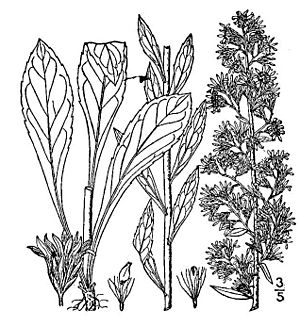Solidago puberula facts for kids
Quick facts for kids Solidago puberula |
|
|---|---|
 |
|
| 1913 illustration | |
| Scientific classification | |
| Genus: |
Solidago
|
| Species: |
puberula
|
| Synonyms | |
|
|
The downy goldenrod (Solidago puberula) is a beautiful wild plant. It is found across eastern North America. This includes places like Nova Scotia and Ontario in Canada. It also grows south to Florida and Louisiana in the United States. It's known for its bright yellow flowers. These flowers usually bloom in late summer and fall.
What is Downy Goldenrod?
Downy goldenrod is a type of plant that lives for many years. This means it comes back each growing season. It can grow up to 100 cm (39.5 in) (about 39 inches) tall. The plant has a strong, woody root system that branches out.
Different Kinds of Downy Goldenrod
Scientists have found two main types, or subspecies, of downy goldenrod:
- Solidago puberula subsp. puberula
- Solidago puberula subsp. pulverulenta
The main difference between these two types is their leaves. Subspecies pulverulenta has many smaller leaves. These leaves are usually 10–40 mm (0.39–1.57 in) long. Subspecies puberula has fewer, larger leaves. Its leaves are typically 40–50 mm (1.6–2.0 in) long.
What Does It Look Like?
This plant often has one to five stems. These stems are usually covered in fine hairs, which is why it's called "downy." The leaves have jagged edges and get narrower towards the tip. Both sides of the leaves are also hairy.
The downy goldenrod produces many small flower heads. There can be anywhere from 15 to 250 flower heads on one plant. These flowers grow in a long, branched cluster. Each flower head has bright yellow petals, called ray flowers. There are usually 9 to 16 ray flowers per head. Inside, there are also 6 to 15 disc flowers. Each disc flower is about 3 mm long.

